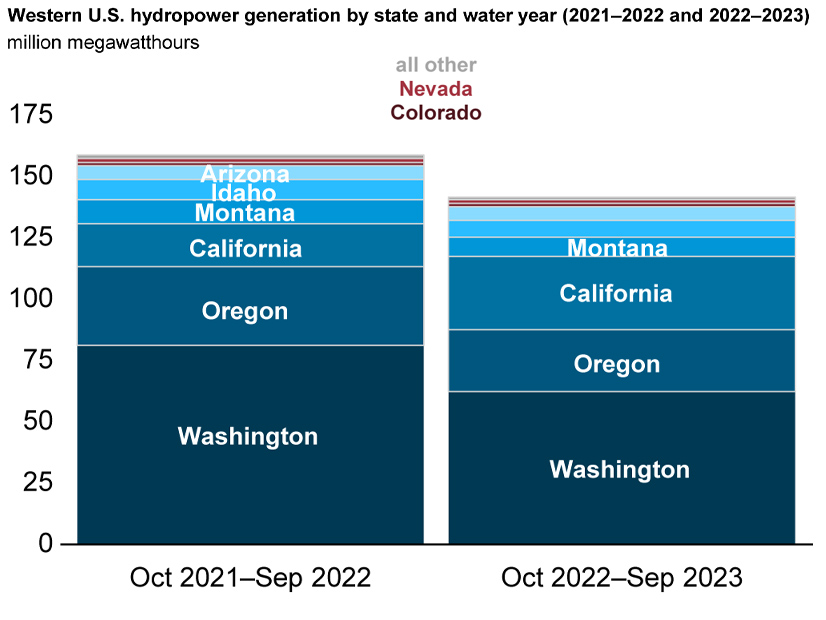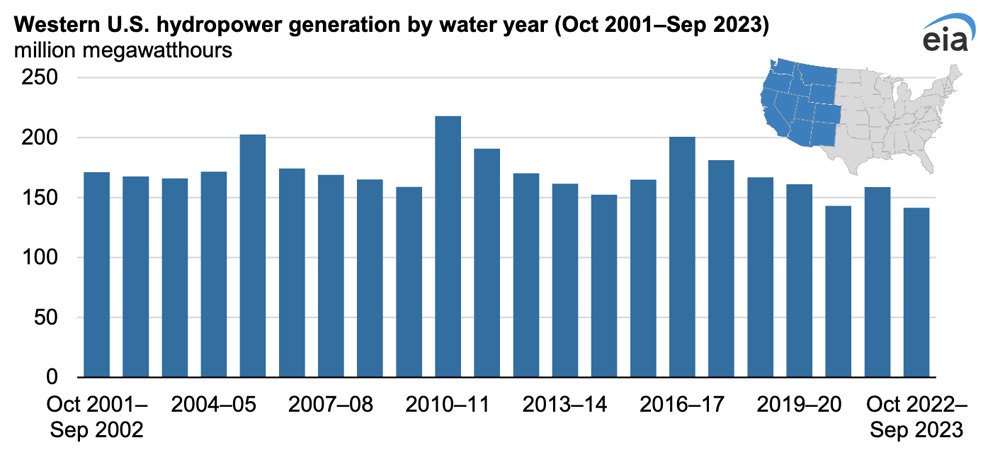
Despite record winter precipitation in California, hydroelectric generation in the Western U.S. fell to a 22-year low in the 2022/23 water year, largely due to droughts in Washington and Oregon, a new analysis found.
Since the 2016/17 water year, Western hydropower generation has been diminishing except for a 13% uptick in 2021/22, according to a March 26 report from the U.S. Energy Information Administration (EIA). A water year runs from Oct. 1 to Sept. 30.
The 2022/23 water year resumed the downward trend, with an 11% drop compared to the previous year. The 141.6 million MWh of Western hydropower generation in 2022/23 was the lowest since 2001.
Previously, the record low was in the 2020/21 water year.
The EIA attributed last year’s drop to drought conditions leading to “historically low” hydropower generation in the Pacific Northwest. Annual hydropower fell by 23% and 20% in Washington and Oregon, respectively.
The 2022/23 water year for the region started with near-normal to below-normal precipitation, EIA noted. But in May 2023, a heat wave in the Pacific Northwest caused temperatures to spike as much as 30 degrees above normal, rapidly melting the snowpack.
“Water flows in May were high, but much of the water supply needed for generation during the summer months melted during the May heat wave,” EIA said. Water supply in the PNW then stayed below average for the rest of the water year, reducing hydropower generation. Tight supply conditions became evident during a five-day cold snap in January when the region was forced to import large volumes of power to meet near-record demand and avert rolling blackouts. (See NW Freeze Response Shows WEIM Value, CAISO Report Says and Powerex Report Expands NW Cold Snap Debate.)
California weather in 2022/23 was dramatically different than in the Northwest. A series of atmospheric river storms dropped record rain and snow on the state from December 2022 to March 2023.
The wild winter left California with its largest snowpack since records began in the mid-1980s. Drought-depleted reservoirs were replenished, and hydropower generation for 2022/23 reached 30.0 million MWh, nearly twice that of the previous year.
The 11 states in the Western region produced about 60% of the nation’s hydropower last year, roughly the same as in the 2021/22 water year.
Washington, Oregon and California produced the most hydropower in the region; Washington and Oregon combined contributed 37% of the U.S. total. The other Western states are Arizona, Colorado, Idaho, Montana, Nevada, New Mexico, Utah and Wyoming.
Elsewhere in the region, Southwestern states had above-normal precipitation in 2022/23. Hydropower generation at Glen Canyon Dam was up 27%. But output was down 11% at Hoover Dam due to water conservation, EIA said.
California’s snowpack appeared to be in good shape March 26, at 102% of the state’s April 1 average, according to the California Department of Water Resources.
Still, EIA is forecasting a 12% drop in hydropower production this water year in the Western market region of California. Similar decreases are expected in the Northwest and Southwest, according to EIA’s short-term energy outlook.
